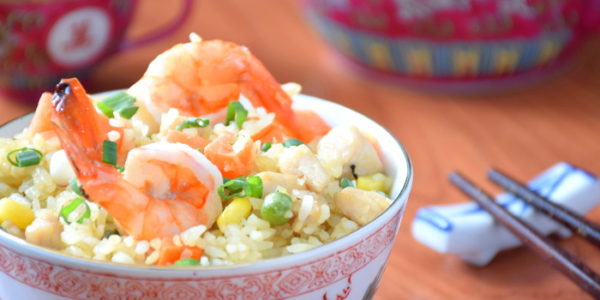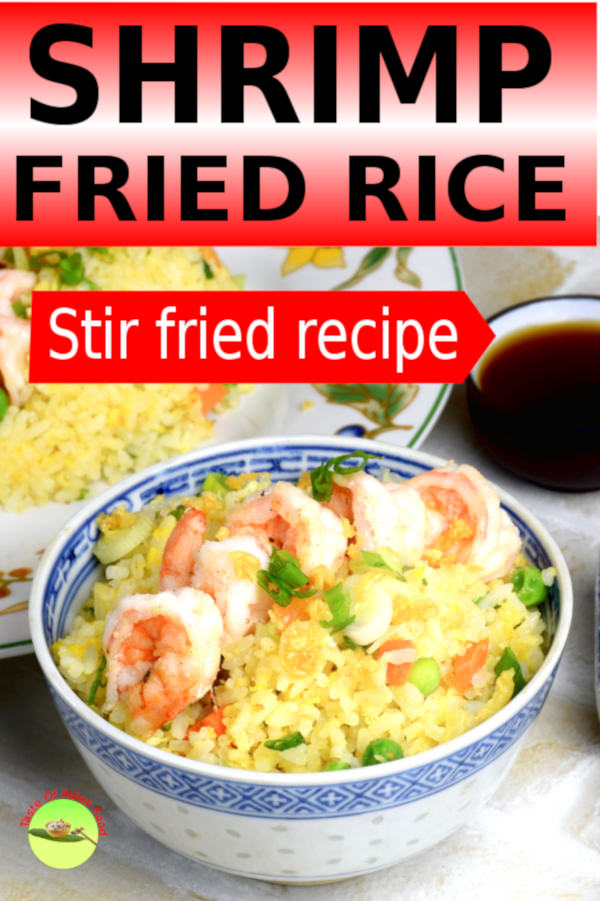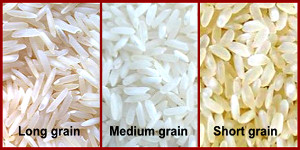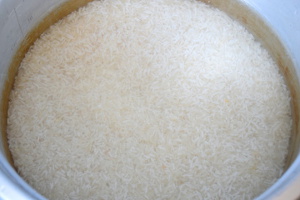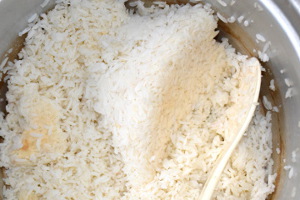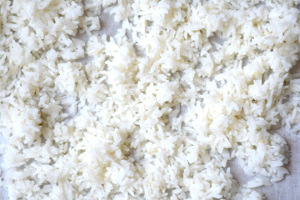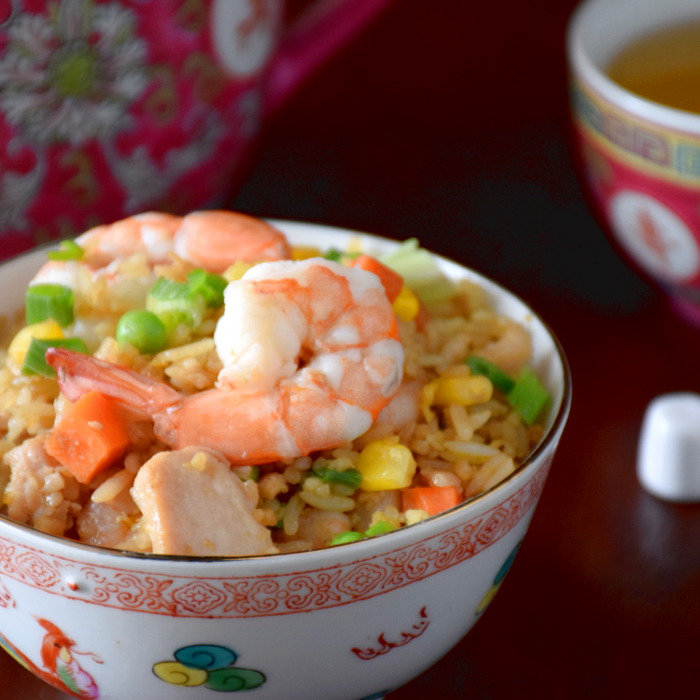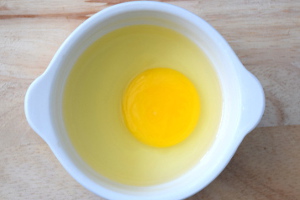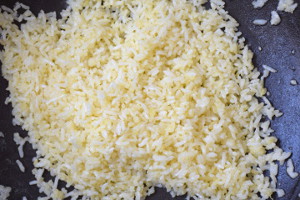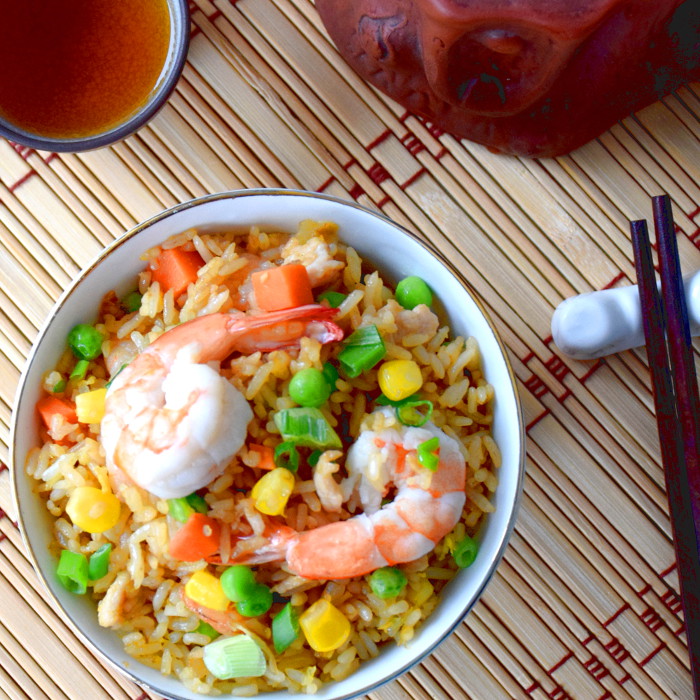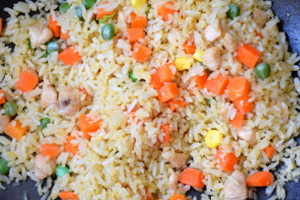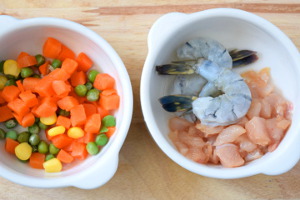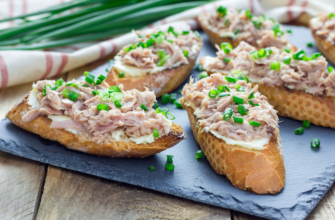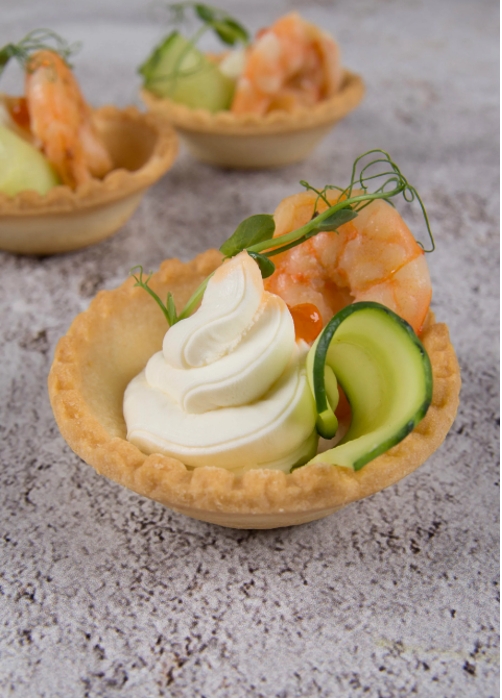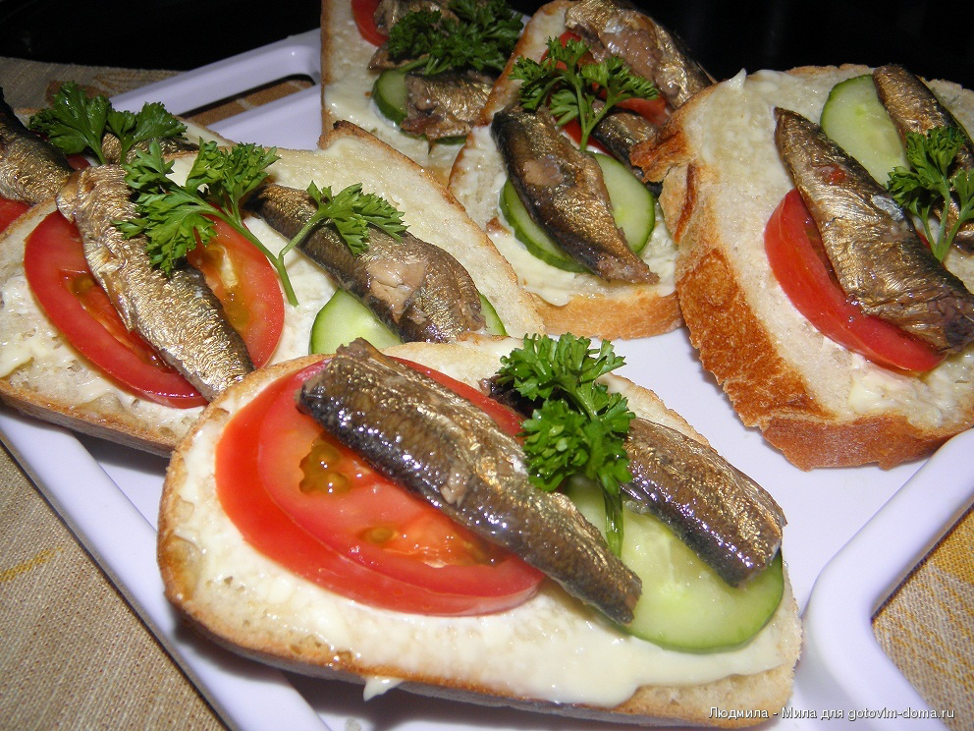- «Chicken fried rice» или «Жареный рис с курицей!» — Ужин по-азиатски.
- Fried rice — Жареный рис
- How to cook the best restaurant style fried rice
- There are two parts in this post
- Ten secrets you need to know to be a fried rice expert
- 1. Use the right type of rice
- 2. Rinse the rice to remove excess starch
- How to do it:
- 3. Fluff the rice to separate the grains
- 4. Dry the rice for perfect browning
- Tips:
- 5. Use seasoning sparingly
- 6. Add an egg for better flavor
- Different ways to use eggs for fried rice
- 7. Use a wok to fry (and what if you do not have one?)
- How to use a pan to fry rice
- 8. Choose the best combination of ingredients
- How to prepare the ingredients for fried rice
- 9. Use the right oil to fry rice
- 10. Fry on high heat
«Chicken fried rice» или «Жареный рис с курицей!» — Ужин по-азиатски.
Привет! Сегодня что-то потянуло на азиатскую кухню.
Если вы приедете отдохнуть в ЮВА, то увидите, что в местных кафешках и «макашницах» повсеместно встречается жареный рис. Он может быть с курицей и креветками, может быть вегетарианский, может быть приготовлен с добавлением чили или без него. Это такое очень универсальное и простое блюдо, которое каждая страна азиатского региона считает своим национальным, но по факту готовят его почти одинаково.
Мы вам сегодня расскажем один из способов его приготовления! А вы, как всегда, сможете с ним поэкспериментировать!
Итак, «Chicken fried rice» или «Жареный рис с курицей!»
И для приготовления 4 порций прекрасного ароматного риса нам понадобится:
- Рис бурый — 240 гр.
- Куриные грудки без кожи — 500 гр.
- Лук зеленый — 50 гр.
- Морковь — 200 гр.
- Горошек — 100 гр.
- Кукуруза — 100 гр.
- Чеснок — 3 зубца.
- Масло растительное — 10 гр.
- Соевый соус — 1,5 ст.л.
- Рыбный соус — 1,5 ст.л.
- Соль, перец, чили перец.
Отвариваем рис. Я советую брать бурый, т.к. он в разы полезнее — нешлифованный рис не так откладывается на наших стройных талиях, дольше усваивается и оставляет нас сытыми. Ну и еще, он просто красиво разваривается 🙂 «в цветочек». Но учтите, что за счет своей нешлифованности он варится дольше обычного, примерно минут 30-40!
Берем куриные грудки. В принципе, вы можете взять и креветки, но в нашем регионе хорошие креветки встречаются редко, поэтому курица. Нарезаем мясо небольшими квадратиками.
Раскаляем вок! Мы готовим азиатское блюдо, поэтому вок. Но если у вас такого в хозяйстве не оказалось, то подойдет и обычный сотейник. Раскаляем, и добавляем туда немного масла. Идеально, если это будет кунжутное масло. Обжариваем подсоленные и поперченные грудки до золотистого цвета. Конечно, тайцы жарят в таком количестве масла, что оно покрывает мясо почти полностью, но мы же следим за фигурой, в отличие от упитанных таек. Поэтому масла немного, исключительно для вкуса, и мясо все равно хорошо прожарится.
Откладываем его в отдельную емкость. Жарим мелко резанный лук. Я использую обычный зеленый лук, или лук порей, или даже репчатый, тут все идет в ход. И добавляем к нему мелко резанный чеснок. Потом резанную кубиками морковь и горошек с кукурузой. Все это интенсивно помешиваем, но недолго, 3-4 минуты. Добавляем снова мясо, рис. Посыпаем щедро чили. Заправляем соевым соусом и рыбным соусом. Нет рыбного соуса — тоже не беда, но уже не то. Хотя бы соевый оставьте! Кстати, самый лучший соевый соус — или аутентичный тайский, или Kikkoman — в составе должна быть только соя, соль и вода. Все остальные красители, колеры, загустители, подсластители в соевом соусе должны отсутствовать. Рыбный соус надо покупать тоже только аутентичный, тайский или вьетнамский, никаких «Стеблей бамбука, сделано в Санкт-Петербурге».
Буквально пару минут все перемешиваем и выкладываем на тарелки. Настоящая тайка подаст это блюдо с перышками свежего зеленого лука и долькой лайма.
Выход порции (примерно, 300 гр., в зависимости от выпаривания, поэтому всегда советую все взвешивать, считать и делить порционно): 438 ккал., белка (Б) — 37 гр., жиров (Ж) — 6 гр., углеводов (У) — 58 гр.
Обратите внимание, что это плотное и сытное блюдо. Зато оно содержит в себе разные виды белка — курица и бобовые, разные виды углеводов — медленные из риса и быстрые из моркови, довольно острое и ароматное, и отлично вас насытит или в середине дня, или через пару часов после хорррошей силовой тренировки!
Успешных вам кулинарных экспериментов и стройных талий.
Источник
Fried rice — Жареный рис
Жареный рис — блюдо, которое присутствует, по-моему, во всех азиатских кухнях. Кроме того, это первое по-настоящему азиатское блюдо, которое я в жизни попробовал — в далеком 1985 году. Меня им угостили в семье дипломатов, которые проработали некоторое время в Малайзии. Вкус был по тем временам весьма необычный, но мне понравилось.
Рецептов жареного риса сотни, если не тысячи, и тот, что представлен здесь несколько адаптирован под нашу реальность. Он похож на тот рис, который я попробовал в молодости, но наверняка чем-то отличается. Продукты, которые понадобятся, доступны каждому, ничего особенного искать не придется.
Длиннозерный белый рис, 1,5 чашки
Яйцо, 1 шт.
Качественная ветчина, или буженина, по вкусу
Морковь небольшая, 1 шт.
Перец сладкий, 1/2 шт.
Цуккини, 1/2 шт.
Имбирь, немного
Чеснок, 2 зубчика
Зеленый лук
Соевый соус, 2-3 ст. ложки
Масло растительное
Острый молотый чили, опционально
Кунжутное масло, 1 ч. ложка, опционально
Важный момент — для наилучшего результата рис для этого блюда должен быть холодным, буквально из холодильника. Лучше его отварить заранее, или использовать оставшийся от другой трапезы белый рис. Про то, что его надо не переварить, думаю упоминать не надо.
Жареный рис — это, по существу, конструктор, как многие азиатские блюда, поэтому начнем с подготовки составляющих.
Для начала яйцо нужно немного взбить и пожарить на минимальном количестве масла.
Источник
How to cook the best restaurant style fried rice
Cooking fried rice is easy, tasty and with a wide margin of error.
You may wonder why I write such a simple recipe in great detail in this post.
There is a catch!
Most Asian restaurants prepare fried rice with high power stove that generates intense heat, which is essential to produce excellent fried rice. However, most people do not have the luxury to have it in your comfy home.
While home stove cannot reproduce the dramatic inferno of wok stove, this post will show you how to dish out the fried rice at par with any Chinese restaurant at home without generating roaring heat in your kitchen
Note: This post may contain affiliate links. Please read my disclosure for more info. I may receive commissions for purchases made through links in this post.
There are two parts in this post
The first part is the video of how to cook the Chinese style fried rice, and the complete recipe.
The second is a collection of ten time-tested fried rice techniques that will transform you into an expert.
These tips will elevate the humble fried rice to the next level, and turn it into a culinary wonder.
Read on …
One thing common to all types of fried rice is that there are a set of universal techniques for any fried rice. The must-have distinct and well-separated grains should be sticky enough to easily pick up with chopsticks or a spoon, the exterior of the grains should be slightly brown and the interior remains soft, and the rice should be slightly chewy to bite.
Before we look closer at these technical aspects, let’s find out which are the various popular types of fried rice and the differences among them.
Ten secrets you need to know to be a fried rice expert
Although each recipe is different, there are certain important techniques and tricks that are universal to follow for preparing any fried rice. As long as you understand and follow them, you are well on the way to cook up a fantastic dish of fried rice every time
1. Use the right type of rice
The best type of rice for frying should be less starchy, fragrant, and have a chewy texture.
Medium grain rice boasts a great balance of chewiness and ability to maintain the shape of individual grains after frying. Thai fragrant Jasmine rice has a perfect balance of stickiness and not easily getting mushy. Both have a superior texture and are best for fried rice.
On the other hand, short grain sushi rice is stickier and starchier. It is easily clumped together during frying. Unless you are preparing Japanese fried rice, this is not an option to look for. Longer grain rice such as Basmati rice lacks the plumpness of medium grain rice, which results in fried rice that is dry and hard.
type of rice
Tips: Medium grain rice is the choice for fried rice.
2. Rinse the rice to remove excess starch
Have you ever wondered what the purpose is of rinsing the rice before cooking?
Rinsing the rice serves two purposes.
Most of the rice in Asia (where I live) is not very clean. The rice should be rinsed to remove any husk, sand, and impurities.
Rinsing will remove the excess starch, the culprit that causes rice grains to clump together while stir-frying.
Therefore, rinsing is far more important for frying rice than boiling plain rice or preparing sashimi and risotto that the stickiness of rice is relevant.
How to do it:
1. Fill a container with clean water. Put the uncooked, dry rice grains in it and stir it with your hand a few times.
2. Remove the starchy water and replace it with fresh water. Repeat four to five times until the water runs clear and no longer starchy.
Note that you do not need to do this if you want to cook plain or biryani rice. You can rinse them once or twice if they are not clean. At the other extreme, you do not rinse Arborio rice to make risotto because you want to preserve as much starch as possible.
3. Fluff the rice to separate the grains
Fluff the rice as soon as it is cooked, as it tends to harden and solidify into a block when it cools down.
When you want to fry the rice, check whether the rice grains clump together. If this happens, break up the lumps with your hands. It ‘s hard to break up the rice during stir-frying.
The rice should separate into individual grains without breaking or getting crushed. The surface of the rice grain should be slightly browned, which creates the signature aroma. You can’t brown the surface if the grains are clumped together, and the aroma (or wok-hei as the Chinese described it) will never be created.
Tips: Fluffy rice is not only good for fried rice. It is also important to serve with plain steamed rice. Make a habit of fluffing the rice immediately after cooking it.
4. Dry the rice for perfect browning
A plate of perfect fried rice should have a slightly brown surface and a soft and chewy center. The surface of the rice grains should be dry enough to get the good browning effect while frying.
The surface moisture of the wet rice can rapidly reduce the temperature, causing the rice to stick together and does not brown efficiently.
Cook the rice with slightly less water than normal. The rice has lower water content and can be fried immediately after cooking without facing the problem of stickiness. However, the rice tends to become too hard and not chewy.
Fried rice cooked with the normal amount of water is not suitable as it will clump together easily.
Tips:
There are a few ways to keep the surface of the rice dry and achieve a good browning effect.
Use overnight rice. Traditional Chinese chefs prefer to use overnight rice to prepare fried rice. However, the grains tend to clump together even it is fluffed. Also, it tends to lose moisture on the surface as well as in the centers of the grains. As a result, it tends to be harder and less chewy.
Use fanned fresh rice. Fluff and spread the rice thinly on a tray. Blow it under a fan until the rice is dry enough for the grains not to clump together. Make sure the rice is not too dry and doesn’t turn hard. Otherwise, the fried rice will be just as hard as the day old rice that has been unattended. This method gives better control over the moisture content than the overnight rice left in the fridge, and it is easier to dry only the surface and keep the centers of the rice grains moist. The rice is also fresh, not stale like overnight rice.
5. Use seasoning sparingly
Generally, fried rice should be seasoned with a small amount of soy sauce, salt, oyster sauce or fish sauce. The flavor of the rice should be highlighted, not the seasonings. While it is generally recommended that fried rice doesn’t need a ton of sauce, Indonesian nasi goreng contain a large amount of chili paste and sweet soy sauce. The following list shows what seasonings are used normally, but there are still plenty of variations in different regions of the world.
Chinese fried rice- light soy sauce and dark soy sauce are used. Some chefs prefer just a pinch of salt to keep the bright color of the rice. If you use too much soy sauce or oyster sauce, the color of the rice will become dark and not aesthetically appealing.
Chinese-American fried rice– tomato ketchup and Worcestershire sauce are used to render a whole new flavor.
Thai fried rice- uses fish sauce, soy sauce, and sugar.
Japanese fried rice– Mirin (sweet Japanese cooking wine), Japanese soy sauce.
Indonesian nasi goreng– sambal (Indonesian chili paste)
Despite the different seasonings, the key to making the fried rice smell aromatic is keeping the rice dry during stir-frying. Therefore adding the sauce little by little to keep the rice dry is the best practice.
Premium light soy sauce with a pinch of salt is all you need to season Cantonese-style fried rice. Other common seasonings are fish sauce, sesame oil, dark soy sauce, white pepper and oyster sauce.
6. Add an egg for better flavor
Eggs are the essential ingredients for fried rice. The simplest egg fried rice (鸡蛋炒饭) only required egg and light soy sauce, which is still a delectable meal by itself. This is analogous to a masterfully prepare plain agleo e oleo spaghetti with only olive oil and garlic. Its success depends on the cook’s skill, nothing less, as there are no other ingredients to enhance the flavor.
Different ways to use eggs for fried rice
Fried and egg.
Just fry an egg (normally an easy-over egg) and put it on top of a plate of fried rice. This is how Indonesian nasi goreng is usually presented. Since Indonesian fried rice contains plenty of chilies, it does not matter that the eggs are not mixed into the rice.
Coat the rice with eggs.
1. Fry the rice in the wok until the grains are slightly brown and smell fragrant.
2. Turn down the heat, add the whisked egg to the rice and mix well. Continuously on low heat until the eggs are fully cooked. (To avoid sticking to the wok, be sure not to turn the heat up before the eggs are cooked.)
3. Once the eggs are totally dry, add the soy sauce, seasonings, and other ingredients.
4. Stir fry on intense heat for a minute to create wok-hei.
This method enhances the flavor of all rice grains with eggs, much like fish fillet is covered in batter. It is a little more technical, but worth the time to perfect the technique.
Cook an omelet. Push the rice to the side of the wok. Pour some oil into the bottom and add a whisked egg to make an omelet. Use wok spatula to break up the omelet into small pieces and mix with the rice. This is a common way to add an egg in most of the fried rice recipes.
7. Use a wok to fry (and what if you do not have one?)
Wok is the best cooking utensil for cooking fry rice. Wok has different zones of heat that make controlling of temperature an easy task. Its spherical shape makes tossing and flipping a snap, with little chance of food pieces falling out as they would from a flat pan. It sits perfectly on the wok burners that can generate intense heat and plenty of wok hei.
However, the wok is not designed to be used on Western-style burners. Stove tops with induction or a heating coil cannot generate as much heat as a wok burner. These are the limitations most home cooks are facing when trying to replicate the restaurant standard fried rice.
There is a workaround, albeit it’s not perfect. Below is my tested method.
How to use a pan to fry rice
1. Use a flat-bottomed wok or pan so that you can place it on a flat stove top.
2. Add some oil to the pan and wait until it is piping hot before adding the rice so that the exterior has a chance to brown.
3. Use a larger pan than what you think is enough. This will help prevent food from falling out during stir-frying.
4. To compensate for the low heat generated by the home burners, stir-fry in small batches. Stir-fry one or two servings each time so that the stove can generate sufficient heat to maintain the heat of the rice over the entire stir-frying process. (This is by far the most important thing you should do.)
5. Keep tossing and stirring to prevent the rice from sticking to the pan.
8. Choose the best combination of ingredients
Fried rice is a perfect dish for using up various leftovers. You can make chicken fried rice of shrimp fried rice out of your leftovers, but the following guideline applies to all types of fried rice.
How to prepare the ingredients for fried rice
1. Cut the ingredients into small pieces. All the vegetables, meat and seafood should be in small pieces so that they can be cooked quickly.
2. Choose something that can maintain the shape and won’t fall apart with constant flipping and tossing. (Which implies that fish meat is not quite suitable. )
3. The egg is the best ingredient for fried rice. It enhances the flavor of all types of fried rice.
4. Use aromatics. Saute the aromatics (garlic, onions, spring onion) with oil. The aromatic oil enhances the flavor of the rice, just like infusing garlic flavor to the oil for a plate of aglio e oleo pasta.
5. Use less liquid. Use a small amount of liquid (soy sauce, fish sauce etc). Adding water is a definite ‘no’.
6. Meat and seafood. Chicken, pork, and beef should be sliced thinly. Prawns and crab meat are good alternatives. Fish meat is not suitable as it will fall apart while stir frying.
7. Vegetables. It depends on the recipes. Chinese fried rice includes chopped spring onions sprinkled on top, whilst Thai fried rice may prefer basil. A mix of frozen green peas, corn, and diced carrots is a convenient combination to add shapes and colors.
9. Use the right oil to fry rice
The choice of oil for fried rice plays an important part to create the authentic Asian flavor. Oils suitable for stir-frying are peanut oil, vegetable oil, and palm oil. They have a high smoking point which is suitable for stir-frying and a neutral taste that will not affect the flavor of the fried rice.
Olive oil and butter are not suitable for cooking oriental fried rice. They do not have a neutral flavor and the smoking point is relatively low.
10. Fry on high heat
There are many ways to fry rice. The proponent of each method vouches that they have the best method. The reality is that there is no ‘best’ method, as it’s all a matter of personal preference. However, producing wok-hei is so tricky that it is often used as a measure of the credibility of a Chinese chef.
When cooked correctly, the “essence” of the food comes from the flavor. The dish is said to “have wok hei 有镬气 “. To impart wok-hei, the food must be cooked in a wok over intense heat while being stirred and tossed quickly. In short, stir-fry the rice on high heat whenever possible.
Источник

